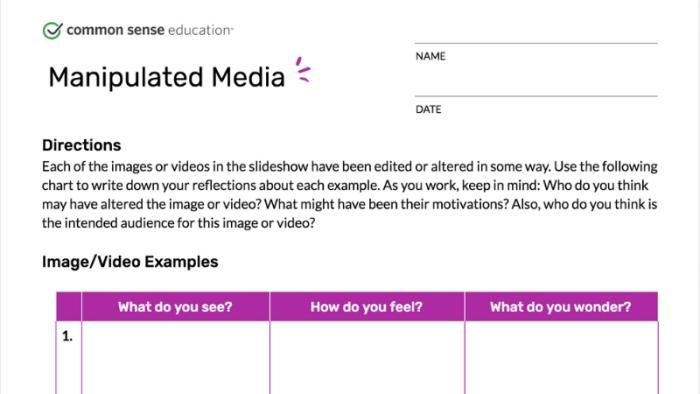Use this lesson plan to help students think deeply about the role of faked and synthetic media in their lives.

Every day, teens engage with countless images and videos that have been edited or digitally altered. From simple Snapchat filters to short, lighthearted, or ironic TikTok videos, it's clear that young people are pretty savvy when it comes to consuming -- and creating -- manipulated media. And in a lot of ways, seeing altered media is just part of being online today.
But are your students aware of -- or have they thought deeply about -- disinformation online, including the phenomenon of deepfake videos? Known more formally as a type of "synthetic media," these altered videos usually show real people doing and saying things they never actually did or said. The thing that makes deepfakes different is that they're created almost entirely with artificial intelligence, or "AI." This technology is advancing quickly, and some experts believe that some of these fakes will soon be nearly imperceptible to the human eye.
"Deepfakes are really the latest incarnation of manipulated media. Think Photoshop on steroids." –Dr. Hany Farid, UC Berkeley School of Information
Use this lesson plan to have your students consider questions like: Why are faked images and videos so popular? How might AI or deepfake technology subvert or threaten a democratic election? And perhaps more universally, How does the existence of this new technology change the way we see the world?
Recommended for:
Grades: 8-12
Subjects: ELA, social studies, newspaper/media, digital citizenship
Prep for teachers
- Preview the media examples in the "Manipulated Media" Google Slide deck. If you'd like to use your own examples, you can simply make your own copy. Please note that the video in slide 8 contains explicit language -- please preview before deciding whether it's appropriate for your class.
- Make copies of the "Manipulated Media" worksheet that accompanies the slides.
In the classroom
Hook (10 minutes):
Before showing the video, give students an essential question for their viewing: "What is deepfake technology, and what are its potential impacts for us, for our democracy, and for our world?"
As students watch, have them practice using questions from the "See, Think, Wonder" Visible Thinking routine to guide their critical thinking: What do you see? What did it make you think about? And, What do you wonder?
Show the video: "Deepfakes and Democracy: Know Before You Vote."
Pressing play on the YouTube video below will set third-party cookies controlled by Google if you are logged in to Chrome. See Google's cookie information for details.
Unable to view on YouTube? You can also watch this video on our site.
Discussion (15 minutes):
After watching, lead a whole-class discussion about the video. Ask your students: What did you see that stuck out to you? What did it make you think about? And, What do you still wonder about after watching the video? You can also follow up with some more direct questions for discussion, depending on time and your class's response to the video:
- Are you worried about what could happen if deepfake videos became more prominent? Why, or why not?
- Should technology companies like Facebook, Google, or YouTube play a role in alerting the public about faked images or videos? Should the government play a role?
- Right now, it's easiest to make deepfake videos of famous people or public figures since the computer algorithms require a lot of existing images and footage to create a fake video. But as the technology advances, experts say, fakes could be made with far less source material (potentially with even just a few photos from public social media profiles). If that happens, how might everyday citizens be affected by this technology?
- What are the potential consequences of deepfake video technology on our legal, criminal justice, or judicial systems?
Whole-class activity (20 minutes):
Ask your class to think about the larger role of manipulated media in our daily lives. Where else do we encounter images, videos, or audio recordings that are manipulated, edited, or altered in some way?
Then, view a series of manipulated images (and one video) in the "Manipulated Media" Google Slide presentation. Each of these examples has been heavily edited or doctored, or completely faked. As you view each example, have students complete the "Manipulated Media" worksheet (a variation of the "See, Think, Wonder" thinking routine from the video activity above). Please note that the video in slide 8 contains explicit language -- please preview before deciding whether it's appropriate for your class.
- Give students time to reflect and record their thoughts on the worksheet.
- As you work your way through the examples, ask students to share their responses and reactions.
Final Discussion/Writing Reflection (5-10 minutes):
Before finishing the lesson, wrap up the whole-class discussion and/or have students complete a five- to 10-minute exit note to tie all their thoughts together. You can use any of the questions above, or return to the lesson's essential question: What are the potential impacts of deepfake technology for us, for our democracy, and for our world?
Possible follow-ups
- Check out all the resources in our News and Media Literacy Resource Center.
- Teach our digital citizenship lesson "Hoaxes and Fakes" to help your students learn more about misinformation, and disinformation, online.
- Review the report from Data & Society titled "Deepfakes and Cheap Fakes: The Manipulation of Audio and Visual Evidence."
Editor's note: This resource is part of a series that helps teachers facilitate classroom discussions about trending and timely issues in the news and media. For more, browse our library of news and media literacy articles.








